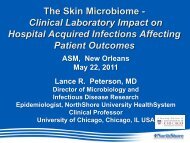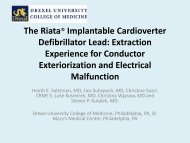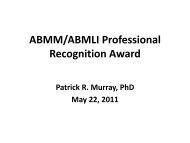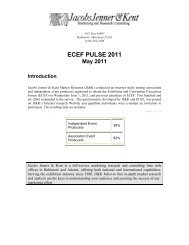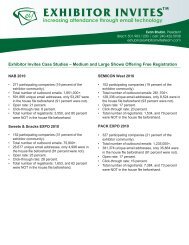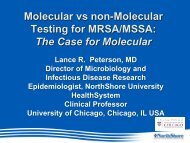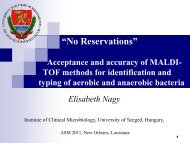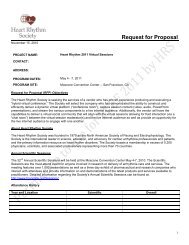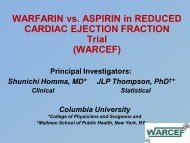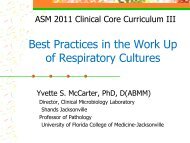Centers for Disease Control and Prevention
Centers for Disease Control and Prevention
Centers for Disease Control and Prevention
You also want an ePaper? Increase the reach of your titles
YUMPU automatically turns print PDFs into web optimized ePapers that Google loves.
Surveillance <strong>for</strong> Antimicrobial<br />
Resistance at the<br />
<strong>Centers</strong> of <strong>Disease</strong> <strong>Control</strong> <strong>and</strong><br />
<strong>Prevention</strong><br />
Jean B. Patel, PhD, D(ABMM)<br />
Deputy Director<br />
Office of Antimicrobial Resistance<br />
National Center <strong>for</strong> Emerging <strong>and</strong> Zoonotic<br />
Infectious <strong>Disease</strong>s<br />
The findings <strong>and</strong> conclusions in this presentation have not been <strong>for</strong>mally<br />
disseminated by the <strong>Centers</strong> <strong>for</strong> <strong>Disease</strong> <strong>Control</strong> <strong>and</strong> <strong>Prevention</strong> <strong>and</strong> should not be<br />
construed to represent any agency determination or policy
Surveillance <strong>for</strong> Antimicrobial Resistance<br />
(AR)<br />
Viruses<br />
Parasites<br />
Bacteria<br />
Mycobacteria
Surveillance <strong>for</strong> Sentinel Resistance<br />
Events<br />
• Identifying unusual resistance in the healthcare<br />
clinical microbiology laboratory<br />
Appendix A<br />
CLSI M100-S21
Detection of Carbapenem-Resistant<br />
Enterobacteriaceae (CRE)<br />
• Reference laboratory identification of new CRE<br />
• Guidance <strong>for</strong> laboratory detection of CRE
CRE in the United States
AR as a Notifiable <strong>Disease</strong><br />
Carbapenem-Resistant Enterobacteriaceae<br />
(CRE)<br />
“More than 350 cases of carbapenem-resistant Klebsiella<br />
pneumoniae, or CRKP, have been reported at healthcare facilities in<br />
Los Angeles County, mostly among elderly patients at skilled-nursing<br />
<strong>and</strong> long-term care facilities, according to a study by Dr. Dawn<br />
Terashita, an epidemiologist with the Los Angeles County<br />
Department of Public Health.”
AR as a Notifiable <strong>Disease</strong><br />
Vancomycin Resistant Staphlyococcus aureus<br />
Case Year Age Source Diagnosis Underlying Conditions<br />
1 2002 40<br />
Plantar ulcers &<br />
Catheter tip<br />
Plantar soft tissue infection Diabetes, dialysis<br />
2 2002 70 Plantar ulcer Osteomyelitis Obesity<br />
3 2004 63<br />
Urine from a nephrostomy<br />
tube<br />
No infection<br />
Multiple sclerosis,<br />
Diabetes, kidney stones<br />
4 2005 78 Toe wound Gangrene<br />
Diabetes, vascular<br />
disease<br />
5 2005 58<br />
Surgical site wound after<br />
panniculectomy<br />
Surgical site infection Obesity<br />
6 2005 48 Plantar ulcer Osteomyelitis MVA, chronic ulcers<br />
7 2006 43 Triceps wound Necrotizing fasciitis<br />
Diabetes, dialysis,<br />
chronic ulcers<br />
8 2007 48 Toe wound Osteomyelitis<br />
Diabetes, obesity,<br />
chronic ulcers<br />
9 2007 54<br />
Surgical site wound after foot<br />
amputation<br />
Osteomyelitis<br />
Diabetes, hepatic<br />
encephalopathy<br />
10 2009 53 Plantar foot wound Plantar soft tissue infection<br />
11 2010 64 Wound drainage Prosthetic joint infection<br />
Diabetes, obesity, lupus,<br />
rheumatoid arthritis<br />
Diabetes, end-stage<br />
renal disease, dialysis<br />
12 2010 83 Vaginal swab No infection Chronic CDI
Surveillance Networks<br />
• Emerging Infections Program (EIP)<br />
• Population based surveillance in 10 states<br />
• State networks consist of public health <strong>and</strong> academic<br />
partners<br />
• National Healthcare Safety Network (NHSN)<br />
• Web-based surveillance of healthcare-associated<br />
infections (HAI)<br />
• Data from different kinds of healthcare-delivery<br />
facilities<br />
• GISP (Gonococcal Isolate Surveillance Project)<br />
• STD clinics in 29 cities supported by 5 regional labs
Another Network…<br />
• Epidemiology <strong>and</strong> Laboratory Capacity Program<br />
(ELC)<br />
• 50 state health departments, 6 local health<br />
departments, Puerto Rico & Republic of Palau<br />
• National Antimicrobial Resistance Monitoring System<br />
(NARMS)<br />
• Surveillance <strong>for</strong> antimicrobial resistant enteric<br />
pathogens from human specimens<br />
… More to come later
EMERGING INFECTIONS PROGRAMS
Active Bacterial<br />
Core surveillance<br />
(ABCs)<br />
Human Papilloma<br />
Virus (HPV)<br />
surveillance<br />
EIP Project Overview<br />
Foodborne<br />
<strong>Disease</strong> Active<br />
Surveillance<br />
Network<br />
(FoodNet)<br />
Healthcare-Associated<br />
Infections/Community<br />
Interface (HAIC)<br />
Influenza<br />
Hepatitis<br />
surveillance
Active Bacterial Core Surveillance<br />
ABCs<br />
Group A & B<br />
Streptococcus<br />
Streptococcus<br />
pneumoniae<br />
Neisseria meningitidis<br />
Methicillin-resistant<br />
Staphylococcus aureus<br />
Case Definition: Isolation of bacteria from a normally sterile body site. The patient<br />
resides in one of the defined surveillance areas
Identifying New Resistance
Measuring Scope & Magnitude<br />
Characterizing New Epidemiology<br />
USA 300<br />
MRSA causing<br />
healthcareassociated<br />
infections<br />
~ 94,000 serious<br />
MRSA infections<br />
in 2005
Cases per 100,000 population<br />
40<br />
35<br />
30<br />
25<br />
20<br />
15<br />
10<br />
5<br />
0<br />
Monitoring Trends<br />
The Introduction of a pneumococcal vaccine in 2000 resulted<br />
in decreased cases of resistant invasive pneumococcal<br />
disease among children<br />
45<br />
Not susceptible to 1 or more<br />
antibiotics<br />
Not susceptible to 3 or more<br />
antibiotics<br />
1998 2000 2002 2004 2006 2008
ANTIMICROBIAL RESISTANCE IN<br />
HEALTHCARE SETTINGS
NHSN Enrollment
NHSN: AR in Device Associated<br />
Infections<br />
• Device <strong>and</strong> procedure associated infections<br />
• CLABSI – Central line-associated bloodstream infections<br />
• VAP – Ventilator-associated infections<br />
• CAUTI – catheter-associated urinary tract infections<br />
• SSI – surgical site infections<br />
• DE – dialysis events<br />
Facilities enter pathogen <strong>and</strong><br />
susceptibility data <strong>for</strong> infections
NHSN: Laboratory Identified AR<br />
Events<br />
• Multi-drug resistant infections/Clostridium<br />
difficle-associated disease module<br />
• MDROs (e.g., MRSA, cephalosporin or carbapenemresistant<br />
Klebsiella, carbapenem-R Acinetobacter<br />
spp., VRE)<br />
• <strong>Prevention</strong> process measure surveillance (e.g.<br />
monitoring adherence to h<strong>and</strong> hygiene or adherence<br />
to active surveillance cultures)<br />
Facilities enter pathogen <strong>and</strong><br />
susceptibility data <strong>for</strong> MDRO<br />
infections
Infections per 1,000 device-days<br />
A national focus on MRSA<br />
prevention yields results<br />
0.45<br />
0.4<br />
0.35<br />
0.3<br />
0.25<br />
0.2<br />
0.15<br />
0.1<br />
0.05<br />
0<br />
MRSA CLABSI<br />
MDR EC/KP<br />
CLABSI<br />
MDR EC/KP CAUTI<br />
2000 2001 2002 2003 2004 2005 2006 2007 2008<br />
Year<br />
MRSA CLABSI rates from Burton DC. JAMA 2009; 301:727-36
CRE Surveillance in NHSN<br />
Resistance among catheter-Associated bloodstream infections (CLABSI)<br />
2009 – 2010<br />
Carbapenem-resistant<br />
bacteria<br />
No. Tested No. Resistant % Resistant<br />
Klebsiella 1826 231 12.7<br />
Enterobacter 1035 42 4.1<br />
E. coli 909 17 1.9
NHSN: Measuring Antibiotic Use <strong>and</strong><br />
Resistance<br />
• Revised AUR Module<br />
• Capable of capturing antimicrobial use data<br />
(administered data) from electronic medical records<br />
• Data will be reported as aggregate institutional use<br />
• The purpose of the data are <strong>for</strong> benchmarking <strong>and</strong><br />
analyzing geographical trends in antimicrobial use<br />
• Capable of capturing antimicrobial resistance data<br />
from electronic medical records.
HAIC<br />
HAI &<br />
Antimicrobial Use<br />
Prevalence Survey<br />
CDI Surveillance<br />
MDR GNB<br />
Surveillance<br />
C<strong>and</strong>idemia<br />
Surveillance<br />
NHSN Networks<br />
Dialysis BSI &<br />
HCV/HBV<br />
Surveillance
• FY2011<br />
HAI Point Prevalence Survey<br />
• One day HAI <strong>and</strong> antibiotic use survey<br />
• Sampling of acute care facilities in EIP<br />
• What data will we get:<br />
• HAI data from all patients<br />
• Data on all HAIs<br />
• Antimicrobial use data from all patients with HAIs
CDI Incidence - PRELIMINARY<br />
Number of Sites 8<br />
Surveillance Period<br />
No. of CDI cases (<strong>for</strong> sites with 12<br />
mo. data)<br />
Estimate 2010 Incidence per 100,000<br />
population<br />
January 2010 to December 2010 (6<br />
sites)<br />
376 to 3,314<br />
61.2 to 215.9<br />
Community associated infections 24 to 52%
NAP12<br />
1%<br />
Pulsed-Field Types by CDI Epidemiologic Class<br />
NAP10<br />
3%<br />
Community-Associated Healthcare-Associated<br />
unnamed<br />
28%<br />
NAP11<br />
8%<br />
NAP9<br />
3%<br />
NAP7<br />
5%<br />
NAP6<br />
9%<br />
CA (N=130)<br />
NAP1<br />
28%<br />
NAP4<br />
10%<br />
NAP5<br />
2%<br />
NAP1related<br />
1%<br />
NAP2<br />
2%<br />
* Cali<strong>for</strong>nia, Connecticut, Minnesota <strong>and</strong> New York<br />
NAP12<br />
1%<br />
unnamed<br />
28%<br />
NAP11<br />
7%<br />
NAP10<br />
2% NAP9<br />
3%<br />
NAP8<br />
1%<br />
NAP7<br />
5%<br />
NAP6<br />
7%<br />
NAP4<br />
7%<br />
NAP5<br />
2%<br />
NAP1<br />
30%<br />
CO-H + HCFO (N=211)<br />
NAP2<br />
1%<br />
NAP3<br />
2%<br />
NAP1-related<br />
4%
GISP – Sentinel AR Surveillance <strong>for</strong><br />
Treatment Guidelines<br />
~ 700,000 new infections each year<br />
Only one class of drug is still active<br />
<strong>for</strong> treatment
GISP – Detecting New Resistance
Preparing <strong>for</strong> Ceftriaxone-Resistant<br />
Neisseria gonorrhoeae
Acknowledgements<br />
• National Center <strong>for</strong> Emerging <strong>and</strong> Zoonotic<br />
Infectious <strong>Disease</strong><br />
• Division of Preparedness <strong>and</strong> Emerging Infections<br />
• Division of Foodborne, Waterborne, <strong>and</strong><br />
Environmental <strong>Disease</strong><br />
• Division of Healthcare Quality Promotion<br />
• National Center <strong>for</strong> Immunization <strong>and</strong><br />
Respiratory <strong>Disease</strong>s<br />
• Division of Bacterial <strong>Disease</strong>s<br />
• National Center <strong>for</strong> HIV/AIDS, Viral Hepatitis,<br />
STD, <strong>and</strong> TB <strong>Prevention</strong><br />
• Division of Sexually Transmitted <strong>Disease</strong> <strong>Prevention</strong>
Thank You



